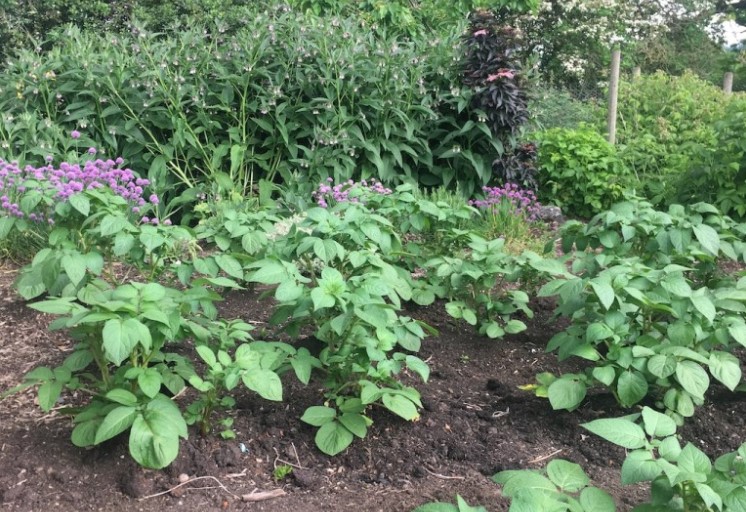Written by Stephanie Hafferty
How to grow using no dig methods veganically, also known as “stock free”, without animal manures or other animal derived inputs.

There’s a bit of a myth that you *have* to include animal manures in composts in order to grow good vegetables. I hear this so often and it simply isn’t the case. Indeed, most home growers are using veganic methods, without even realising it.
Of course all healthy gardens have animals and wild creatures as part of the whole ecosystem – that’s something we no dig gardeners whatever our composts actively encourage. This way of growing is not about excluding animals or soil life, but not using manures from farming and products such as fish, blood and bone. Obviously all healthy soils and composts have animal remains and poo in them, whether it is worm poo or the poo from a passing hedgehog.
Exploring ways of making plant based composts is so useful for all home gardeners and allotmenteers, especially those growing on smaller scales, because for many people composting food waste or accessing bulk animal manures can be difficult. So this article is for everyone, whatever you chose to eat.
Veganic No Dig Gardening

There is something of a myth in gardening communities that in order to have a healthy plot you have to use animal manures, that composts and feeds made entirely of plants lack sufficient nutrients, minerals or other properties essential for the growing of edibles. Of course, this is simply not the case, as an increasing number of veganic no dig gardeners are proving with their abundant harvests and healthy soil.
Many home gardeners and allotmenteers use mostly veganic methods without realising: comfrey feeds and seaweed are all plant based, domestic compost heaps too usually only contain garden waste, kitchen peelings and other plant matter.
 No dig gardening methods fit beautifully with vegan principles. Working with nature, no dig focuses on protecting soil and soil life, feeding the flora, fauna and microbes that ensure a healthy environment for our vegetables and wildlife. To put it simply, we don’t dig the soil. None of this so-called “traditional” annual double digging of plots, incorporating matter or broad forking either. These methods destroy the delicate structure of the soil, breaking up the soil food web and harming fungi, microbes and other soil life, as well as worms. Instead, the mycorrhizal fungi is left intact, the soil open, alive and free draining not by human intervention but by the natural processes of the soil life itself. Crucially, no dig methods help to lock in carbon. Of course one has to dig a hole to plant a tree, or wiggle a parsnip loose to harvest it, but as much as possible no dig gardeners are as considerate of the soil life as they are of the bees, birds and other wild creatures that share our outdoor spaces with us.
No dig gardening methods fit beautifully with vegan principles. Working with nature, no dig focuses on protecting soil and soil life, feeding the flora, fauna and microbes that ensure a healthy environment for our vegetables and wildlife. To put it simply, we don’t dig the soil. None of this so-called “traditional” annual double digging of plots, incorporating matter or broad forking either. These methods destroy the delicate structure of the soil, breaking up the soil food web and harming fungi, microbes and other soil life, as well as worms. Instead, the mycorrhizal fungi is left intact, the soil open, alive and free draining not by human intervention but by the natural processes of the soil life itself. Crucially, no dig methods help to lock in carbon. Of course one has to dig a hole to plant a tree, or wiggle a parsnip loose to harvest it, but as much as possible no dig gardeners are as considerate of the soil life as they are of the bees, birds and other wild creatures that share our outdoor spaces with us.
There are many different ways of creating a no dig garden, depending on your location and climate. Here in the UK an annual mulch of compost feeds the soil and reduces habitat for wild creatures that you really don’t want living close to your edibles. Our climate favours an abundance of slugs, snails and woodlice, all a vital part of the ecosystem but not ideal companions for home food gardens and allotments. We create wild edges away from veg beds where woodlice, snails and slugs can live happily.
 An annual mulch of compost feeds the soil and soil life for a year. That is the key – it is about feeding the soil rather than the plants! If the soil is in good heart then the plants are able to grow healthily and access the nutrition and moisture vital for their growth. I add 2-3 cm of compost a year to all of my beds at the allotment and home. This is enough to feed the soil for a whole year, even if you grow year round like I do. The mulch and not digging combined helps to conserve moisture, reducing watering.
An annual mulch of compost feeds the soil and soil life for a year. That is the key – it is about feeding the soil rather than the plants! If the soil is in good heart then the plants are able to grow healthily and access the nutrition and moisture vital for their growth. I add 2-3 cm of compost a year to all of my beds at the allotment and home. This is enough to feed the soil for a whole year, even if you grow year round like I do. The mulch and not digging combined helps to conserve moisture, reducing watering.
The compost mulch is rich with biodiversity, supporting a lot of wildlife as well as the soil and plants, creating a habitat for black beetles and many other insects. Birds forage there, toads hibernate in it during the winter months.
 I mostly use home-made composts made from garden waste, kitchen waste, comfrey, nettles, urine, cardboard, old natural fibre towels that are falling apart etc. Composted leaf mould and wood chip are excellent, too. Whatever you use, make sure it is well rotted – brown, crumbly, with a rich, delicious smell of earthiness.
I mostly use home-made composts made from garden waste, kitchen waste, comfrey, nettles, urine, cardboard, old natural fibre towels that are falling apart etc. Composted leaf mould and wood chip are excellent, too. Whatever you use, make sure it is well rotted – brown, crumbly, with a rich, delicious smell of earthiness.
You can buy council green waste compost which is usually veganic (do check as some contains food waste with who knows what in) which is ideal for mulching, especially when starting a new area on weedy ground, but is not very nutritious so do add some homemade compost or a good plant based feed (comfrey, nettle, seaweed) to give it some ooomph.
Other additions you can buy include pelleted comfrey (sprinkle on as is or soak to make a liquid feed), rock dust and seaweed meal. I know people who have had great success mulching with foraged seaweed (gathered from above the tide line) and also spent hops: use the resources in your location.
To start no dig on a weedy plot, there are several methods you can choose from – use whichever works best for your circumstances. First of all mow or strim the weeds low, rake them up and adding to the compost heaps, manually removing woody weeds such as brambles and docks. If it has been very dry weather, water the ground well first.
Different ways to start no dig:
1. Spread brown cardboard (tape and staples removed) or thick layers of damp newspaper (to stop it from flying off) over the weeds and cover with 5 – 15 cm of compost, as much as you have. Tamp down with the back of a rake or walk gently over the top and you can plant right away
2. Spread 15cm of compost on top of the cut weeds, tamp down and plant.
3. Spread less rotted compost and nutritious leaves (comfrey, nettle etc) over the grass and cover with a large sheet of pre-used polythene (ask around, there’s usually some to be had, I have a sheet that is 15 years old). If you do this in summer/autumn and leave until the following spring it should have rotted down into compost whilst killing the weeds. Another option is to do this in late spring, plant good sized squashes through holes into the soil beneath (if they are big they are less likely to be harmed by slugs) for a crop whilst sheet mulching. This method does create a habitat for slugs etc so it is worthwhile removing the polythene a few weeks before you want to plant to encourage the slugs to slither off.
4. As above, but use cardboard weighed down to prevent it flying off. Worms love cardboard. You’ll need to recover several times over a 6 month period but card is usually free for the asking.
I prefer to have earth paths with a little compost on top. They are easy to hoe and the plants in the neighbouring beds can root into them, too. A very light sprinkling of partially rotted wood chip (think a few millimetres rather than centimetres) is good too. A deeper wood chip mulch can create a home for woodlice which, contrary to popular belief, do like to nibble on fresh plant matter as well as decaying wood.
This works even for plots which are full of bindweed, couch etc. During the first year you will need to be especially vigilant and remove any perennial weeds that pop through the mulch with a trowel or Hori Hori. After the first year or so, they have usually died off.
We keep the beds weed free mostly by hoeing but also removing any weeds manually before they can become too established. This reduces habitat for slugs etc and makes a healthier growing environment for the plants. It makes it easier to intercrop too, increasing your productivity in the garden as you can grow more veg.
During 2018 I decided not to mulch my allotment (it has been no dig now for 10 years) and use homemade feeds instead. I made huge barrels of comfrey and nettle feed, adding other weeds and wild plants from the neighbouring hedgerows and watered the beds with that instead. That year we had drought conditions for some time, but the beds still produced plenty of delicious food. It did mean more watering, so more work than is usual for my no dig plot, but it is certainly an option for anyone with little compost.
For pots and other containers, I add a little extra compost every year and my homemade liquid feeds – mainly comfrey and nettle but also a plant tea made from mares tail. I dry bunches of these to make plant teas in the winter, add to compost heaps or sprinkle into compost.
Creating a wildlife rich habitat is an important part of my gardening, especially at home. In my back garden I have a very rickety greenhouse and a fine 12 x 40ft polytunnel, both maintained using no dig methods, which significantly increase my ability to grow year round. The garden feeds a wide range of creatures: bees, butterflies, moths, hoverflies, bats and birds. I do not use any insecticides, encouraging instead beneficial predators, but do use crop protection, mainly enviromesh and butterfly netting.














